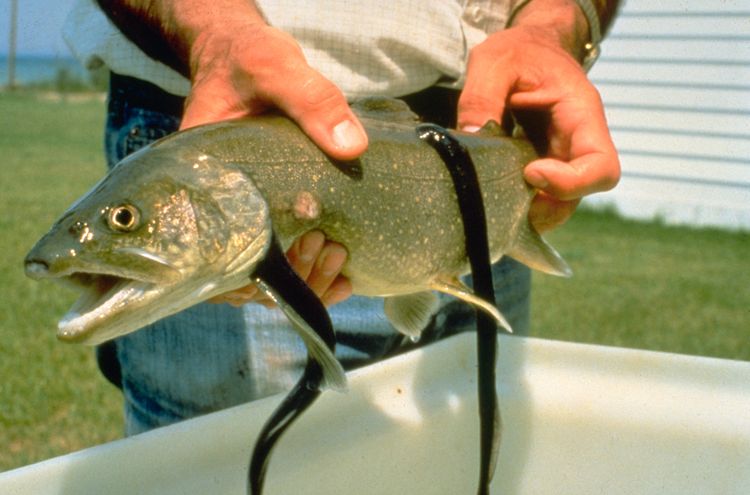GRAND RAPIDS, Mich. (WOOD) — Researchers are starting a 10-year project to keep so-called “vampire fish” out of Michigan rivers.
Over the last 20 years, three dams have been removed along the Boardman-Ottaway River in a massive effort to restore the river, according to Michigan State University. The only one that’s left is the Union Street dam in Traverse City, standing between the river and Lake Michigan.
The dam is aging and has had unintended consequences on native wildlife, but it can’t just be removed. Doing so would allow invasive species like sea lampreys and others into the river, making it much more difficult and expensive to try to control those populations.
“We face a particular challenge here in the Great Lakes, that’s common to other places in the world, and that is that if we freely reconnect our rivers to the lakes or oceans and other places, it increases the possibility that invasive species move into those rivers and cause harm to the species that are in there,” sea lamprey expert Michael Wagner, an associate professor at MSU, told Nexstar’s WOOD. “There can be ecological and economic damage.”
Wagner said despite humans trying to help fish pass over dams for 400 years, “we’re still not really very good at it.”
“These dams are critical to being able to control this really harmful species, but they have other consequences that we want to work to alleviate,” he said.
The Great Lakes Fishery Commission has put together a team of researchers from MSU and other universities to work on FishPass, a project that broke ground in May and will replace the Union Street Dam. The goal is to let fish like walleye and lake sturgeon into the Boardman-Ottaway River while keeping out invasive species.
FROM ‘CUTE LITTLE LARVAL FISH’ TO PARASITE
Sea lamprey are native to the Atlantic Basin. They got into the Great Lakes around 100 years ago through canal systems connecting the lakes to the Saint Lawrence Seaway, Wagner said.
For most of its life, the sea lamprey is a harmless larvae.

“The first four years of their life, they’re this cute little — cute to biologists — but cute little larval fish, living in the sediments of rivers and living off of organic matter and actually doing some positive things for the ecosystem,” Wagner explained.
But after four years, the lamprey turns into its juvenile form, developing eyes and a mouth with tons of teeth. It also stops eating things like algae, instead attaching itself to fish like lake trout and whitefish, earning it the nickname “vampire fish.”
“(They) drill a hole into the side of the fish using a toothy tongue that they have, and then they live off of blood, fluids and some tissue,” Wagner said.
The sea lamprey will stay in that parasitic phase for 12 to 18 months. During that time, it will kill around 40 pounds of fish, Wagner said. A lot of the fish it kills are ecologically, economically and culturally important in the Great Lakes area.
“Uncontrolled, they decimated lake trout populations. They extirpated some native species from the system,” Wagner said. “That’s why Canada and the U.S. got together and said, ‘We really need to control this species,’ and have been doing so with great success ever since.”

SO HOW WOULD FISHPASS HELP?
After 12 or 18 months, the sea lamprey stops eating for good. It will migrate back into a river to spawn and die, Wagner said.
FishPass would trap the sea lamprey as it tries to get into the river, about a month before the nocturnal, solitary critter would naturally die.
“How would you catch a fish that’s by itself at night and doesn’t eat?” Wagner said. “You can’t exactly bait a hook.”
Sea lamprey use odors to navigate their way into rivers and spawning grounds. The larvae produce an odor that tells the sea lamprey it’s a good habitat, and sexually mature males will produce a pheromone to attract females.

On the flip side, when a sea lamprey is bitten by a predator, it releases a warning chemical that others can smell, something Wagner compared to a smoke alarm.
Researchers hope to use those two attracting and deterring odors to guide sea lamprey away from the river passageway and into a trap.
“From their perspective, everything is normal,” Wagner said. “The technique that we’ve been experimenting with is can we use this alarm cue to keep them out of the fish passage device and guide them over into another area of the stream where maybe we can use attractants or other approaches to get them into a trap and catch them.”
He noted that it’s important to trap the sea lamprey, because otherwise it might eventually ignore the repellent odor and go into the river anyway.

“They need to get upstream to spawn. They have this one shot in their life. They could, as they become increasingly desperate to get to the spawning grounds, choose to ignore the risk,” Wagner explained. “Just like you might choose to ignore a smoke alarm if you need to run through the building to get out because the door is on the other side.”
The goal of the project is to eventually automate the selective passageway, but for now, researchers will be monitoring and tagging all fish that go through the passageway, according to MSU. Trapped sea lamprey will be used for further research, public outreach on invasive species and in classrooms for dissection.
If the project is successful, the sorting system can be used at other spots in the Great Lakes and throughout the world, something Wagner said would be a “critical conservation advance.”
“It is cutting edge work that we’re doing … for a problem that we believe can be solved,” he said.
